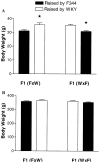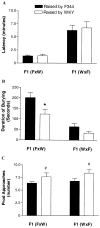Maternal behavior modulates X-linked inheritance of behavioral coping in the defensive burying test
- PMID: 15158425
- PMCID: PMC3760164
- DOI: 10.1016/j.biopsych.2004.02.014
Maternal behavior modulates X-linked inheritance of behavioral coping in the defensive burying test
Abstract
Background: Complex behavioral traits such as coping strategies in response to stress are usually formed by genetic and environmental influences.
Methods: By exploiting the phenotypic and genotypic differences between the Wistar Kyoto (WKY) and Fischer 344 (F344) inbred rat strains, we recently identified three X chromosome-linked quantitative trait loci contributing to differences in coping strategies in the defensive burying (DB) paradigm. In this article we study the influence of postnatal maternal environment in these behaviors by characterizing the maternal behavior of these strains and the effect of cross-fostering on DB behavior of male offspring from reciprocal crossing (F1).
Results: Maternal behavior of WKY rats can be quantitatively characterized by less contact and more periods of neglect of their F1 pups. In contrast, F344 mothers engaged in more active behaviors such as licking/grooming and arched-back nursing. Cross-fostering male F1 pups at birth did not influence the latency to bury measure in DB; however, duration of burying and prod approaches were influenced by both genotype and maternal environment in an additive manner.
Conclusions: These results demonstrate that different measures of behavioral coping in the DB paradigm are influenced by maternal environment to differing degrees and in addition by genetic factors.
Figures




References
-
- Ahmadiyeh N, Churchill GA, Shimomura K, Solberg LC, Takahashi JS, Redei EE. X-linked and lineage-dependent inheritance of coping responses to stress. Mamm Genome. 2003;14:748–757. - PubMed
-
- Canetti L, Bachar E, Galili-Weisstub E, De-Nour AK, Shalev AY. Parental bonding and mental health in adolescence. Adolescence. 1997;32:381–394. - PubMed
-
- Champagne F, Meaney MJ. Like mother, like daughter: evidence for non-genomic transmission of parental behavior and stress responsivity. Prog Brain Res. 2001;133:287–302. - PubMed
Publication types
MeSH terms
Grants and funding
LinkOut - more resources
Full Text Sources
Medical
Miscellaneous

